
This was the view of the rocks from the balcony of our room. The balcony runs the entire length of the hotel and is accessible from all the rooms. This is the back side of the rocks; the monasteries all face the Kalambaka side. I suppose that is why our hotel was a "bargain" compared to its sister hotel on the Kalambaka side. We didn't see anything else like this sandstone formation in Greece. Everywhere else was marble and harder rock (igneous? I have no knowledge of geology). This looked more like Arizona or somewhere in the American west. I could see why the monks had been drawn to the rocks.
Breakfast at the hotel was in the large downstairs breakfast room with giant picture window views of rocks, and we can see they are building a swimming pool. The mood music was hilarious 80s slow dance jams (Lady in Red, Wonderful Tonight, etc.). I'm not sure if they were trying to set a romantic mood but I was highly entertained, if not aroused. Finally, yogurt! It is as good as I had hoped. At home I get Fage (which we saw in Greece with its Greek name--I recognized the logo and then sounded out "Faya," the name is the same) or Trader Joe's fat free yogurt. You can't get down as much of the yogurt with fat because it is too rich. I also made an "omelette" with the scrambled eggs, sauteed mushrooms, tomato slices, and cheese slices and had a croissant with some Nutella-like spread. A good hearty breakfast for a day of climbing the monasteries is a necessity.
Practical info: Six monasteries are open to the public (though it turned out our last stop, St. Stephen, was closed for the day) and can be visited for 2E each. There is shoulder parking or a parking lot at all of them. Varlaam and Grand Meteoron are the largest with the most to see but are absolutely stuffed with bus tours. The bright side at those monasteries was listening in on some English tourguiding to understand what we were seeing. St. Stephen is the easiest to access, and I suspect on days it is open it is even more choked with coach tour passengers than Varlaam and Grand Meteoron.
Holy Trinity was the longest climb I'd say, but all except St. Stephen require a hearty climb on well-cultivated trails and stairs. Wear comfortable, supportive shoes. I was in my ubiquitous Dansko sandals, of course, and they served me as Danskos do--perfectly. I was really amazed at the shoes on some women. High heels! They have much higher pain tolerance than I. It is possible to spend a day hiking between the monasteries, and it actually looked like a really nice thing to do (but quite strenuous).
The dress code is quite strict. Women must wear skirts that cover the knee (no pants) and shirts that cover the shoulder; men must wear pants and shirts with sleeves. For those out of compliance, wrap-around skirts (women) or drawstring pants (men) are provided to wear over your offending clothing (no need to remove your pants before wrapping around the skirt). The signs say both sexes must wear long sleeves but there was no enforcement of this one; I wore a sweater or carried a silk wrap to cover my arms out of an abundance of respectfulness.
The first monastery, Grand Meteoron, was established in 1382 and the others followed within the century or so. Most of them are quite small, and the chapels are teeny with every inch crammed with frescos. Most of the frescos have survived to this day in impressively vivid color. I am always amazed at frescoes because they are painted directly on the wall. Talk about pressure not to make a mistake!
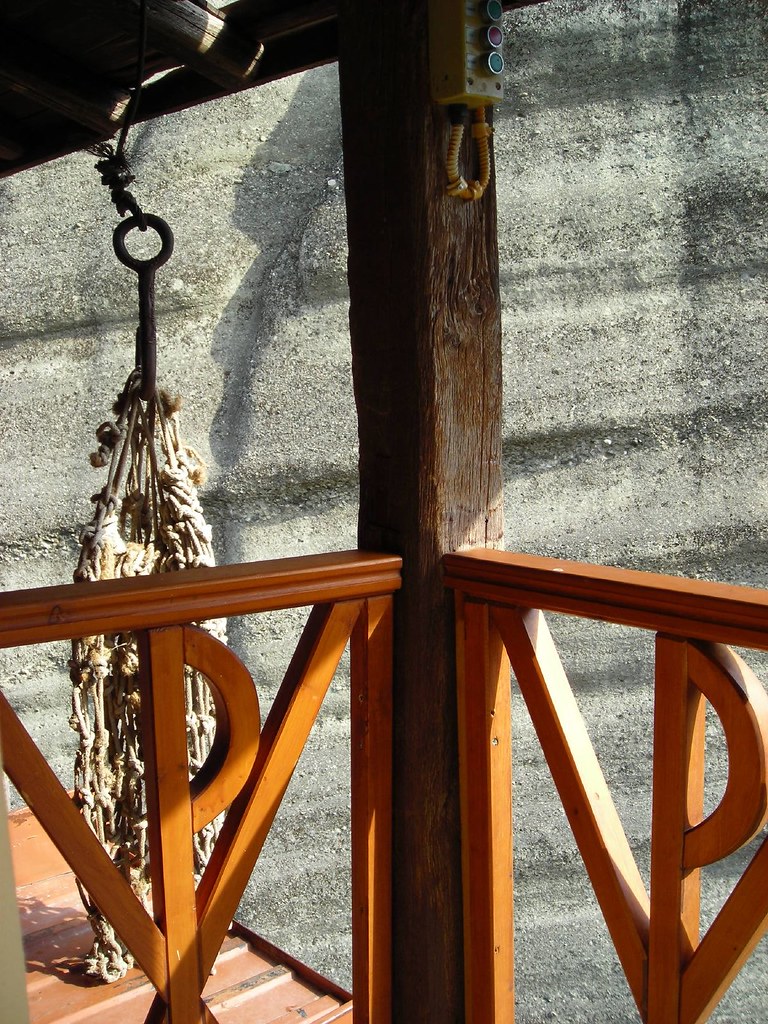 I'm not sure how the monasteries were approached back in the day. The paths and stairs used by tourists today were mostly built in the 1920s. However, I do know how supplies were received back in the day. Each of the monasteries has a giant pulley and winch system with a net on a wicked looking iron hook that can be lowered to the bottom of the rocks. Very ingenious. From what I've read on the internet, it's possible that people used to use the pulley nets as well for their transport. That would be quite a ride.
I'm not sure how the monasteries were approached back in the day. The paths and stairs used by tourists today were mostly built in the 1920s. However, I do know how supplies were received back in the day. Each of the monasteries has a giant pulley and winch system with a net on a wicked looking iron hook that can be lowered to the bottom of the rocks. Very ingenious. From what I've read on the internet, it's possible that people used to use the pulley nets as well for their transport. That would be quite a ride.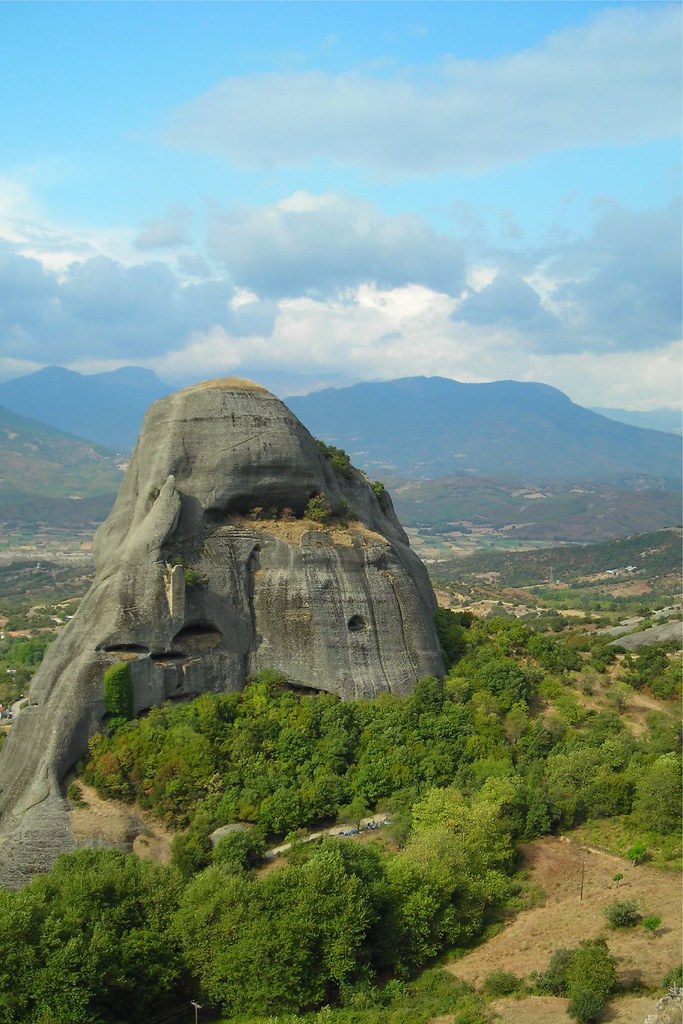
At one time there were a couple dozen monasteries in existence. Most of them have gone to ruin, and you can see bits of ruins everywhere! Click on the picture to enlarge and you'll see a ruined wall and a ruined support.
The first one we visited was Anapafsas, known for its fresco of the naming of the animals by Adam. This was an interesting piece because most of the frescoes on all the sites are dark, both in color and in theme. Gruesome martyrdoms are a favorite subject, portrayed in exquisite, bloody, painful detail. The naming of the animals is a lighter topic, the colors were lighter, and the style seemed deliberately primitive, rather than the more ornate Byzantine style.
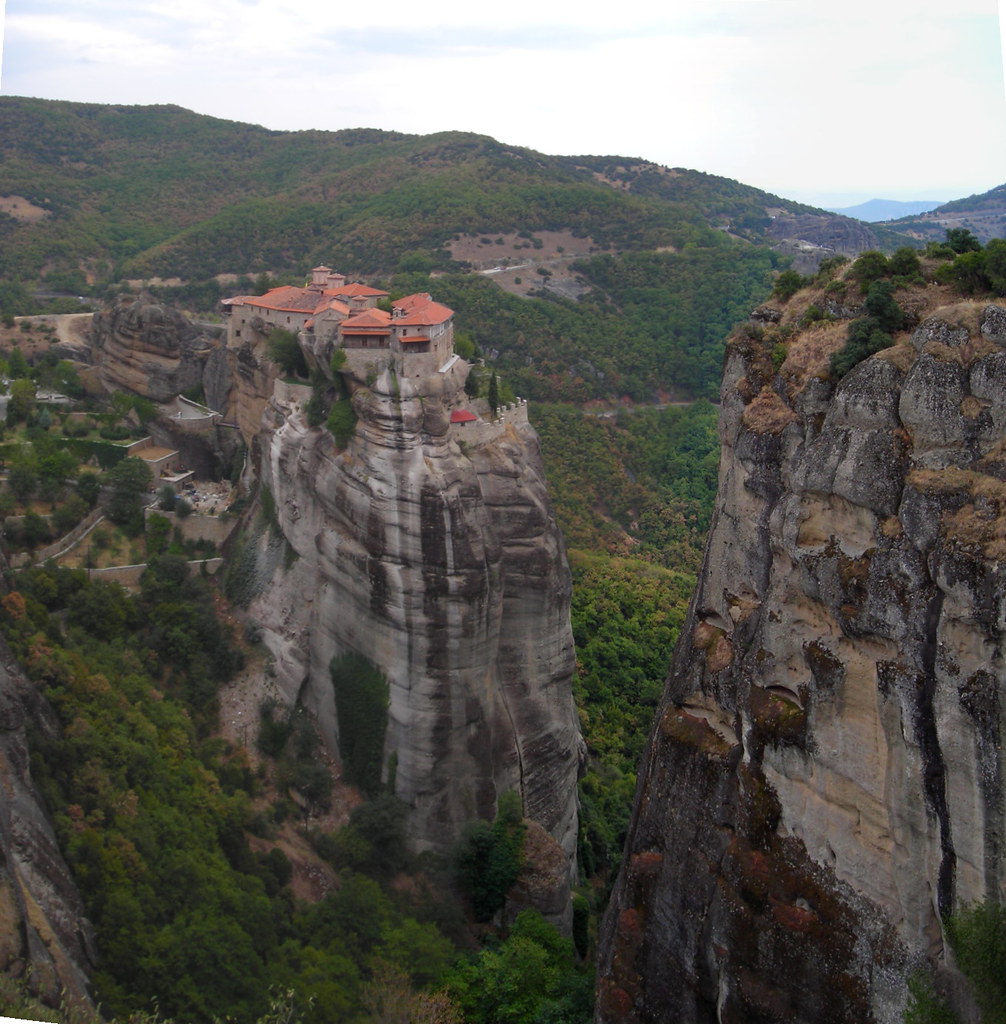 Second Stop was Agia Varvara Rousanou (Saint Barbara); seen from above in the pic it has the most dramatic location at the tip of a rock spire. Two of the monasteries are for nuns; the Greeks use the same word "monastery" for both what we would call a convent and a monastery. Very egalitarian. Rousanou is a monastery for nuns, as is St. Stephen. Rousanou has the distinctive architectural detail of wooden bridges between little rock spits. The nuns make beautiful embroidered textiles, and K and I each bought some. I hadn't been carrying my whole bag, just my camera and some money for admission fees so I had only 9E on me, which bought me six white lace-ish doilies. I'm thinking they will make great cap sleeves on a little blouse or dress.
Second Stop was Agia Varvara Rousanou (Saint Barbara); seen from above in the pic it has the most dramatic location at the tip of a rock spire. Two of the monasteries are for nuns; the Greeks use the same word "monastery" for both what we would call a convent and a monastery. Very egalitarian. Rousanou is a monastery for nuns, as is St. Stephen. Rousanou has the distinctive architectural detail of wooden bridges between little rock spits. The nuns make beautiful embroidered textiles, and K and I each bought some. I hadn't been carrying my whole bag, just my camera and some money for admission fees so I had only 9E on me, which bought me six white lace-ish doilies. I'm thinking they will make great cap sleeves on a little blouse or dress.Our third visit was to Varlaam. At this one the kitchen and dining hall are open to the public, which was great. The kitchen has absolutely giant kettles in it for making lots and lots of soup. The dining hall was quite large and, according to signage, a good example of Monastic architecture. It had instructional paintings all around symbolizing various aspects of the Greek Orthodox Church.
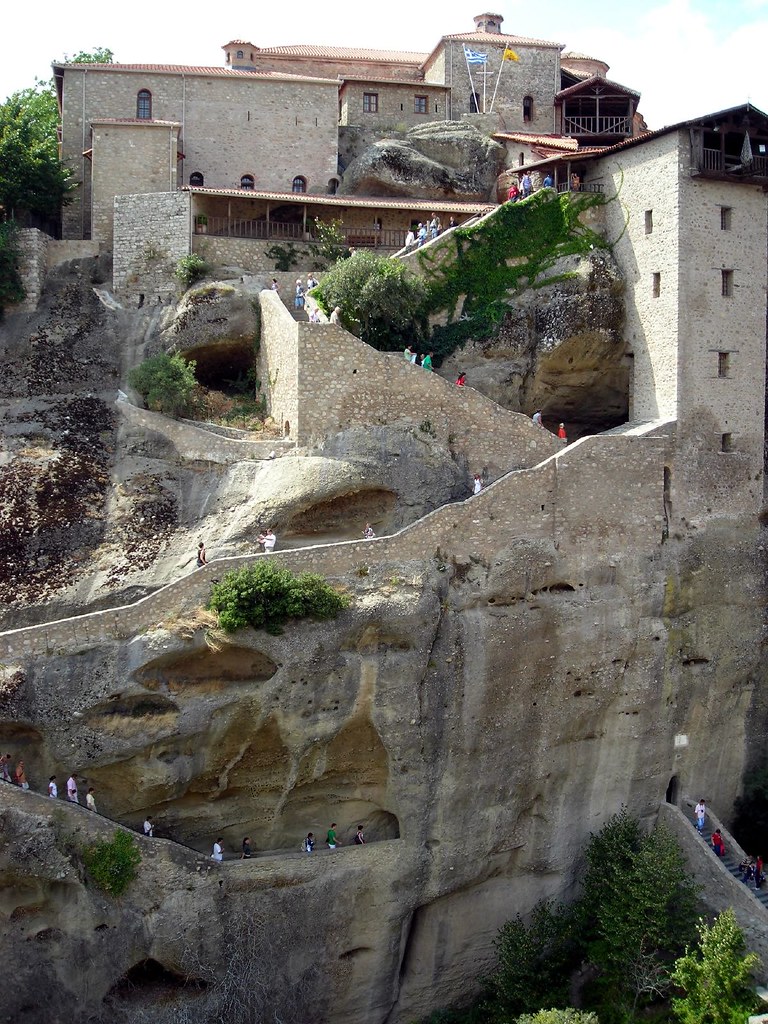 Next came Grand Meteoron. The approach to Grand Meteoran is the most photographable, you can see the layers of stairs going up and up. Believe it or not, it is one of the easier climbs. In addition to the usual features, this has a couple of museums on site. My favorite was the museum of folk history, with traditional costumes and a collection of WWII propoganda, including a Nazi falling off a precipice. There was also a museum with religious items, including priestly garments and intricately carved wooden crosses.
Next came Grand Meteoron. The approach to Grand Meteoran is the most photographable, you can see the layers of stairs going up and up. Believe it or not, it is one of the easier climbs. In addition to the usual features, this has a couple of museums on site. My favorite was the museum of folk history, with traditional costumes and a collection of WWII propoganda, including a Nazi falling off a precipice. There was also a museum with religious items, including priestly garments and intricately carved wooden crosses. Many people find the most thrilling aspect of Grand Meteoran to be the Ossuary, a closet of skulls. There was no explanation on site, but according to the internet (I have no opinion on the veracity) because burial space is so limited monks are given a proper burial and left in the ground for three years, then the body is retrieved and the skull neatly shelved in the ossuary. No word on what happens to the rest of the bones.
Leaving Grand Meteoron was one of the worst experiences of K's life (and she was in the Balkans during the war with nightly bombings!). We pulled out of our tight paralell spot on the shoulder and drove about 50 meters only to be faced with a tour bus. The impassive driver kept nudging forward, so K figured she had to back up. Straight uphill. In a standard transmission. I thought we'd only have to back up a little bit, and then the bus would let us go around, but he had no intention of doing so. We kept going up and up, sweating and fearing for our lives while the inexorable driver kept nudging his way forward. It was insanity! We finally got to the parking space we had left which, thank goodness, was still available and got back in it.
The bus passed, we waited a few minutes to recover our breath and try to relax our fight or flight muscles. I got out of the car and ran down the street to make sure nobody was just around the bend and K pulled back out. I am not doing a good job of conveying how terrifying this was, but it was terrifying! It's worth it to park way far down from Grand Meteoron to avoid this situation, I'd think. I am so glad K was on driving duty that day because there is absolutely NO WAY I could have done that. I can't back up under the best of circumstances, nor can I paralell park. We would have been crushed by a tour bus, quite an ignominious death. Perhaps they would have added our skulls to the ossuary.
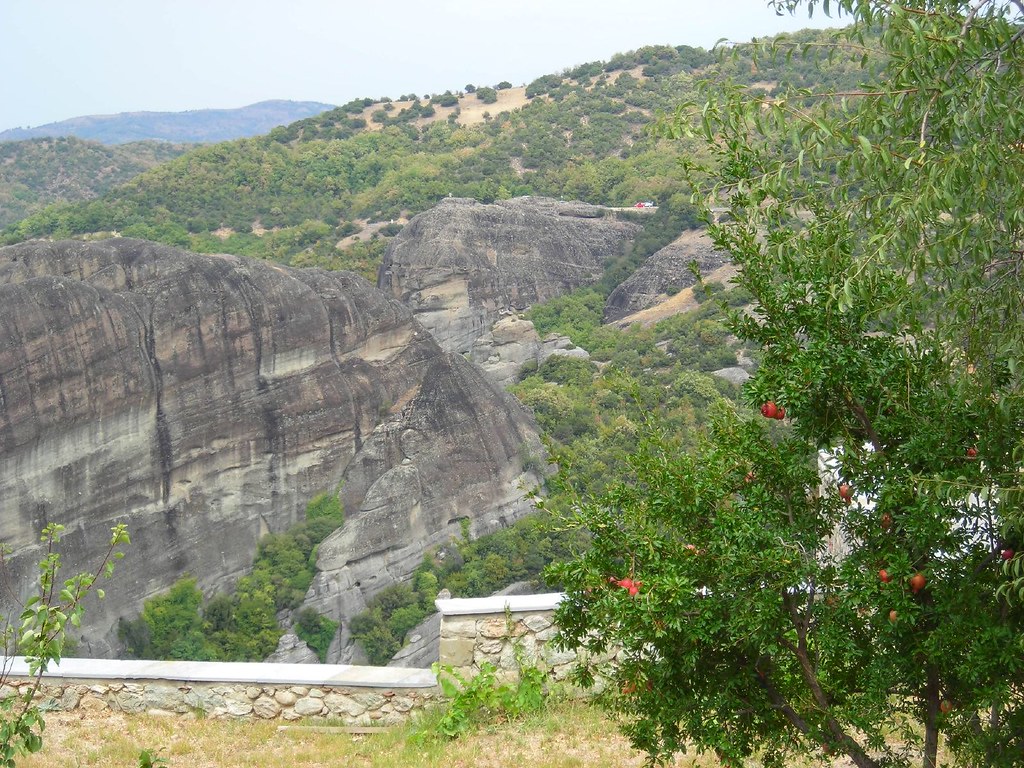 Our fifth and, it turned out, final monastery of the day was Agia Triada (Holy Trinity). The hike to Holy Trinity is the longest with the most elevation change, but I enjoyed it. It certainly deterred most of our fellow tourists and we had it pretty much to ourselves. I think it had the smallest chapel of all. The garden just outside the door is lovely, and even has a pomegranate tree (in the pic).
Our fifth and, it turned out, final monastery of the day was Agia Triada (Holy Trinity). The hike to Holy Trinity is the longest with the most elevation change, but I enjoyed it. It certainly deterred most of our fellow tourists and we had it pretty much to ourselves. I think it had the smallest chapel of all. The garden just outside the door is lovely, and even has a pomegranate tree (in the pic). 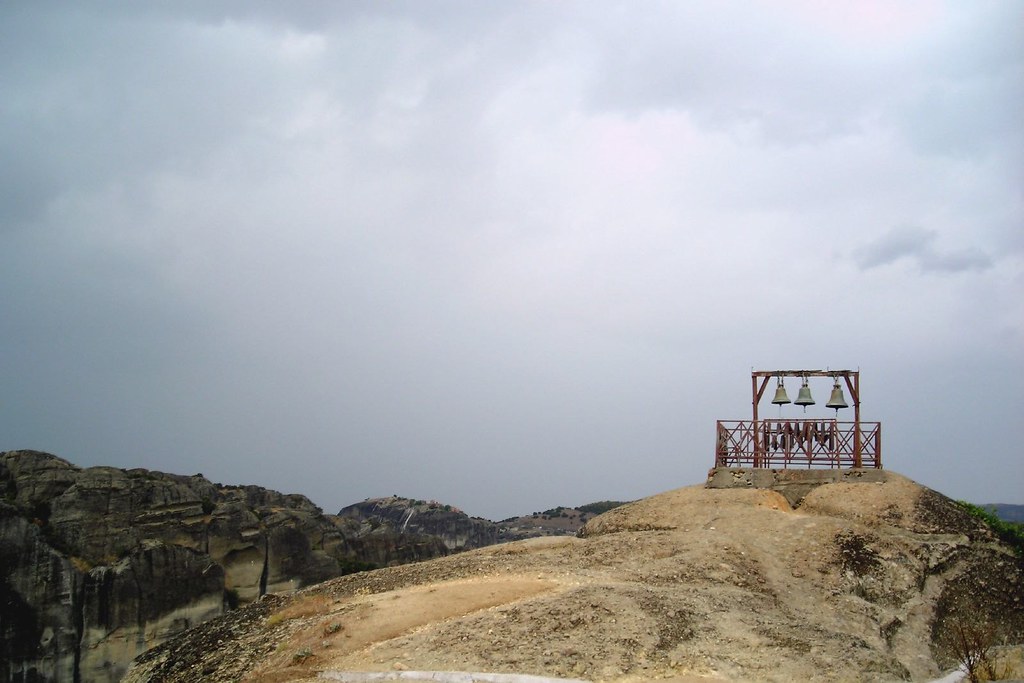 The weather had been fractious all day, with fitful sun and drizzle, and it was now getting windy with threatening clouds. I needed to use the restroom so I followed the signs for the WC away and away to a lonely outcropping. The small carillon is there and the wind was blowing so hard they were pinging like wind chimes. The whole scene was very Bronte with the howling wind and lowering gray clouds; I expected Heathcliff to appear at any moment. I used the Outhouse at the End of the World. It was a turkish toilet, but it did have running water for handwashing with a bucket to catch the runoff, I assume to be used for watering the garden. I can imagine water must be scarce up there on the rocks. Holy Trinity's modern claim to fame is that it appeared in the James Bond film "For Your Eyes Only."
The weather had been fractious all day, with fitful sun and drizzle, and it was now getting windy with threatening clouds. I needed to use the restroom so I followed the signs for the WC away and away to a lonely outcropping. The small carillon is there and the wind was blowing so hard they were pinging like wind chimes. The whole scene was very Bronte with the howling wind and lowering gray clouds; I expected Heathcliff to appear at any moment. I used the Outhouse at the End of the World. It was a turkish toilet, but it did have running water for handwashing with a bucket to catch the runoff, I assume to be used for watering the garden. I can imagine water must be scarce up there on the rocks. Holy Trinity's modern claim to fame is that it appeared in the James Bond film "For Your Eyes Only."I was looking forward to our visit to St. Stephen, as the nuns there were described as "businesslike" and sellers of souvenirs. I like the idea of supporting nuns with my tourist dollars. I had raced to the car from Holy Trinity and beat the rain, K was not quite so lucky. We drove to St. Stephen and waited out the worst of the downpour and then braved it to get to the gate, only to find it closed. Oh well.
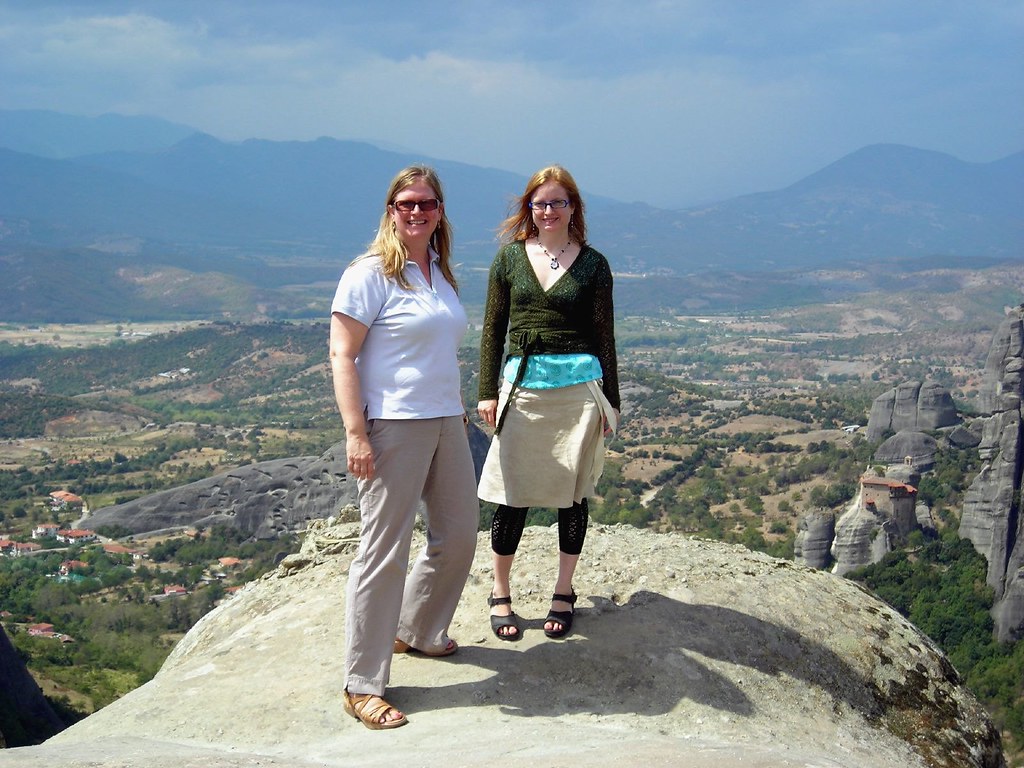 There are turnoffs on the road to get scenic views, so we went to one to take pictures at some point. I don't have a huge fear of heights, but I am very cautious around them. I crept out to the edge of the rock for this one, and the effect is mind-boggling. We are as high up as we look and there is a sheer drop about 4 feet behind us. After I crept back to a safer spot I was just enjoying the view and the sensation of the location. A man was sitting down messing around with his SLR camera near us, and he dropped a lens cap. Luckily, he subdued his first instinct to go after it and we all watched as it rolled in slow motion down down down and out of sight. There were many reminders of mortality on this day.
There are turnoffs on the road to get scenic views, so we went to one to take pictures at some point. I don't have a huge fear of heights, but I am very cautious around them. I crept out to the edge of the rock for this one, and the effect is mind-boggling. We are as high up as we look and there is a sheer drop about 4 feet behind us. After I crept back to a safer spot I was just enjoying the view and the sensation of the location. A man was sitting down messing around with his SLR camera near us, and he dropped a lens cap. Luckily, he subdued his first instinct to go after it and we all watched as it rolled in slow motion down down down and out of sight. There were many reminders of mortality on this day.We drove down into Kalambaka and stopped at To Kipos for lunch, recommended by my guidebook (Eyewitness). After the disaster at Paradeis, the guidebook redeemed itself. We had Greek salad and grilled mushrooms. The mushrooms were white button, rather than the wonderful Oysters we'd been having, but they were very well-prepared. With water for lunch and water for the road the total was 14E.
You can see all my pictures from Meteora and all the photos from this trip to Greece if you'd like.
No comments:
Post a Comment